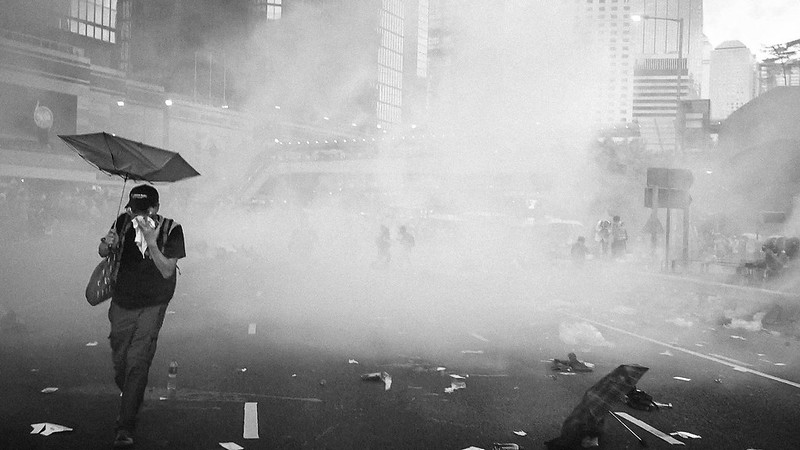photo by Studio Incendo
In the past few days since the beginning of the protests for the murder of George Floyd by Minneapolis Police, there has been a large amount of misinformation spread on the riot control agents that militarized police use in order to harm and deter protesters.
In the era of COVID-19, it is imperative that protesters know what chemical agents they’re dealing with and how to prevent long-term lung and airway damage, as well as how to apply appropriate first aid to those who may have been injured by the deployment of riot control agents such as tear gas.
What is Tear Gas?
To start, tear gas is not a gas. Despite what you may have heard, and despite the misleading name, tear gas, or CS gas, is a crystalline powder that is propelled from a canister using a small explosion. The active chemical compound in tear gas, 2-chlorobenzalmalononitrile, is fine and glass-like.
2-chlorobenzalmalononitrile targets the human pain receptors TRPA1 and TRPV1, both of which trigger the human body to produce tears, mucus, and sweat in order to expel the substance from the body. However, 2-chlorobenzalmalononitrile is designed to adhere directly to any fluid that your body manufactures, meaning that the longer you’re in the “gas”, the more of your body the chemical adheres to, causing you severe pain.
There are other riot control agents that are sometimes referred to as tear gas as well, and target the same pain receptors in the human body via different means. Common types of tear gases include oleoresin capsicum (pepper spray), dibenzoxazepine (CR gas), and chloroacetophenone (CN gas).
Pepper spray is the most familiar to us, as it is capsaicin based and can be calmed using fat (hence the protesters that recommend you carry milk, which is not a great idea, more on that later) but the other two chemical agents are similar to CS gas in that they are fine powders propelled by an incendiary device.
How Do I Protect Myself?
The first step in preventing severe bodily damage from a tear gas attack is to cover up as much as humanly possible. Swim goggles over your eyes are your best bet, because they have very low breathability. Ski goggles are alright, but they are often designed to prevent fogging, and allow more air in than swim goggles. If you don’t have either, any eye protection is better than nothing, if you have safety glasses or even sunglasses, wear them. Do not wear contacts. Tear gas and pepper spray can get trapped between your contact and your eye, causing corneal irritation and damage.
A protester in Fort Wayne had his eye destroyed when he was hit in the face with a tear gas canister. Protect your eyes/head, consider the possibility of including a helmet or hard hat of some kind when you protest as well.
Covering your mouth is paramount. Tear gas and pepper spray easily bind to your saliva and mucus and will enter your stomach and lungs, causing severe irritation. You should already be wearing a mask, but if you have an extra bandana or t-shirt, adding an extra layer of protection over your existing COVID-19 mask will reduce the particulates you inhale and will also allow you to lose one face covering without being entirely exposed to the virus + more gas as you get out of the situation.
You should also be wearing layered clothing, so you can strip down in the event of an attack and to protect your sweat glands from being exposed to the gas. Padded gloves/work gloves can be worn in order to throw canisters back at police, but be warned, the canisters are incredibly hot, and you should not handle them if you do not have intense protective gear on. Do not kick canisters. Unless you were a star football player wearing steel-toed boots, you have no idea where the canister will land, and you’ll likely break or burn your foot. You can, however, take a page out of the Hong Kong protester’s book and carry a traffic cone and water in order to contain/put out tear gas canisters.
What to Do if Exposed
If you are exposed to tear gas DO NOT apply milk, Maalox, baking soda, or any other mixtures or agents other than water. Remember, tear gas is a crystalline powder and antacids/fats will not lessen your pain or wash away the powder as effectively as water. In fact, milk can cause infections and further irritation by getting into the microtears in your skin that come from the 2-chlorobenzalmalononitrile particles.
You must immediately flush any and all exposed skin with water. After that, get out of the area and strip off exposed clothing. The only way to get full relief and to ensure that you will not get further lung/gland damage is to wash yourself and your clothing/gear thoroughly.
Though severe side effects from tear gas exposure are rare, they do happen. Any damage done to our lungs while COVID-19 is still spreading endangers us and weakens our ability to fight the virus anyway.
Pepper spray, however, is a capsaicin gas and some basic solutions can reduce the pain, thought I still do not recommend using them. The white cast that baking soda and other antacids cause on skin can make you more identifiable and the antacids themselves can be incredibly abrasive and itchy once they dry.
If you are a cooking show binge-watcher and spicy food connoisseur, you know that milkfat also doesn’t neutralize or even bind to the oils in capsaicin, it just washes them away like water (only less effectively).
If you really want the potential to neutralize the pepper spray, alcohol and other sugars do bind to capsaicin and can reduce burning/assist in washing away the oils, but plain water does the job. Just keep flushing it out and prioritize getting to a place where you can wash your body. Don’t touch your face, don’t touch other people.
The most important thing to do is get away from the gas when it is deployed. Get to fresh air or high ground. When you strip down, make sure you have some kind of sealable plastic bag with you in order to dispose of your clothing.
Do not touch the clothing with bare hands. If you are asthmatic, bronchodilators do help. When you are able to get to a shower, wash in COLD water for at least 20 minutes in order to flush as much of the riot control agent you were exposed to from your body. Doing all of these things can ensure that you minimize damage to your body.
If you are exposed to tear gas, you should seek out professional medical attention if you can in order to be monitored.







Be First to Comment